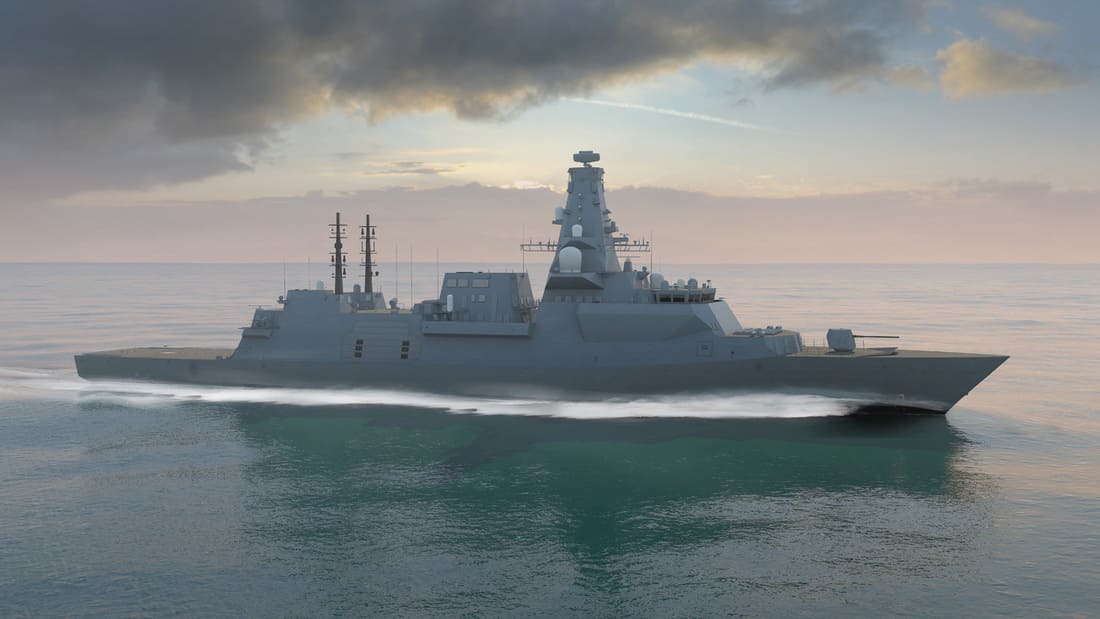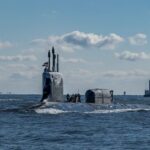Norway chose the United Kingdom’s Type 26 design for its next frigate fleet and set the contract value at about £10 billion, roughly $13.5-$14 billion. Oslo named the UK a strategic partner and confirmed a minimum buy of five ships. The selection was announced on Aug. 31, 2025 after a competition that included proposals tied to France, Germany, and the United States.
First delivery is planned for 2030. Norway consulted the Storting’s Enlarged Committee on Foreign Affairs and Defence before the selection and called the program its largest defense capability investment to date. Officials expect a decades-long service life for the class.
Both governments signed a framework in Stavanger that sets a strategic arrangement and clears the path to a binding contract, with public confirmation four days later.
The ships will be built at BAE Systems’ Clyde facilities in Glasgow. The production plan aligns with the eight Royal Navy Type 26 frigates already in build, creating a combined run of at least thirteen hulls across the two navies. Final assembly stays in the UK, not in Norway.
Contract value and schedule
Program cost is approximately £10 billion for the initial five ships, about $13.5-$14 billion. The procurement makes the UK a long-term partner on design, upgrades, and sustainment. Deliveries begin in 2030 and continue into the 2030s under the Long-term Defence Plan mandate.
The competition lasted approximately nine months. Norway weighed offers linked to the French FDI, Germany’s F126, and the US Constellation-class before downselecting the UK entry, favoring an ASW-optimized hull in the Type 26 size and endurance band.
Program governance for the frigates is separated from helicopter choices. Norway confirmed the ships will embark anti-submarine helicopters but hasn’t named the type, which moves on a separate track to protect the ship schedule.
BAE Glasgow production
Clyde yards at Scotstoun and Govan remain the center of gravity. UK and Norwegian statements link the export deal to ongoing Royal Navy work on eight Type 26 hulls to support common processes and reduce change risk.
According to industry contacts, the production concept treats the UK and Norwegian runs as one integrated stream with batch procurement of long-lead items and shared supplier frameworks. European reporting cites discussion of a “single, integrated, 13-hull production line” centered in Glasgow, pending final contracting.
BAE Systems and Kongsberg signed a 2025 memorandum on industrial links across sensors, effectors, and integration work relevant to surface combatants. The agreement opens supply-chain roles for Norwegian firms tied to the Type 26 architecture.
Eight Type 26 frigates for the Royal Navy are already in build or under contract, replacing the Type 23 ASW fleet. Export derivatives include Australia’s Hunter-class and Canada’s Canadian Surface Combatant. Norway’s choice aligns with allies fielding the same baseline hull, which eases allied trials and future software loads.
Interoperability and crew exchange
Norway and the UK asked for ships “as identical as possible” with “the same technical specifications.” The aim is maximum interoperability, common training, and reduced life-cycle cost from shared spares. Oslo’s defense minister outlined potential crew interchange on a case-by-case basis once procedures and clearances align.
Interchangeability requires matching combat-system baselines and harmonized software drops. Coordinated test windows let each navy’s trials feed certification for the other, saving scarce range time. Crewing concepts will move through training and qualification pilots before any routine swap at sea.
Weapons sensors and helicopter plan
The Royal Navy baseline pairs the Sea Ceptor air-defense system with the Type 997 Artisan 3D radar, a 5-inch gun, strike-length vertical launch cells, and an ASW suite built around a towed array and quiet CODLOG propulsion. This template is the reference for Norway under the “identical as possible” directive, final fits depend on contract details.
Type 26 includes an integrated mission bay sized for boats, unmanned systems, or containers. Propulsion uses a Rolls-Royce MT30 gas turbine with diesel-electric drive for low-noise ASW speeds. The design supports long transits and low acoustic signatures in the Norwegian Sea.
Norway’s helicopter choice for the frigates remains open. Government releases say the ships will embark ASW helicopters, while the type is still under review. Norway previously selected six MH-60R Seahawks to replace the retired NH90 fleet in coast guard and ASW roles with deliveries through 2027. The frigate program could leverage that line, however the ministry hasn’t committed to a single airframe.
Program documents keep uncrewed aviation on the table. Officials want a margin for unmanned systems to extend sensor reach or handle persistent tasks. The mission bay and flight deck sizing support this without major redesign.
The baseline British sensor fit lists Artisan as the primary air and surface radar. Open sources describe it as a medium-range 3D array with strong clutter rejection and capacity for hundreds of tracks. Sea Ceptor provides point and local-area defense from canistered VLS cells, including quad-pack options used by other navies. Norway hasn’t published a definitive missile loadout yet.
The new class will replace the four active Fridtjof Nansen-class ships. Norway lost KNM Helge Ingstad in 2018 after a collision near Bergen, leaving four Nansen hulls in service. The Type 26 restores capacity and adds margin in power, cooling, and combat-system throughput over the older design.
Norway ended the NH90 program with contract termination and ongoing legal action. Acquisition authorities moved to stabilize maritime aviation with the MH-60R buy. The frigate program now keeps options open while hull work proceeds, which limits schedule risk on the ship side.
UK Type 26 weapons include a 127 mm gun forward, Sea Ceptor cells amidships, and strike-length Mk 41 cells for longer-range weapons, plus space for close-in systems. Under “identical as possible,” Norway is expected to stay close to this layout unless a national system requires substitution.
Program status in the UK supports Norway’s timeline. Multiple City-class hulls are structurally complete or in advanced fit-out at Glasgow, which underpins the export flow and the 2030 first-delivery target to Norway.
Wider context
Both governments link the deal to alliance posture in the High North. Common hulls, common sonar tactics, and shared P-8 coverage support coordinated anti-submarine barrier operations. Rear Admiral Oliver Berdal tied identical capability to building a stronger barrier in the Norwegian Sea, using the same hull for UK and Norwegian crews.
Training cooperation is also planned. Identical bridges, engineering plants, and combat systems make simulators and schoolhouses interoperable, helping both navies field crews faster and rotate sailors between billets without long conversion courses.
Storting oversight continues. The government briefed the legislature’s enlarged foreign affairs and defense committee and posted the decision record with schedule milestones and the intent to finalize detailed contracts.
The UK release frames the deal as a strategic partnership and points to job support across the supply chain. Those claims sit outside Norway’s requirements, but they show how the export run anchors the Clyde line for years.
BAE’s product literature outlines the Type 26 architecture in depth. The design centers on a quiet ASW hull with a large mission bay, CODLOG propulsion, and margin for future electronics. Australia and Canada took that architecture in national directions, while Norway opted to stay close to the British spec to speed introduction.
Norway’s surface-force recapitalization predates this decision. The navy operates four Nansen-class frigates and invested in P-8 maritime patrol aircraft and other systems aligned with the UK and US fleets. The Type 26 purchase fits that path and closes the gap left after the loss of Helge Ingstad.
Our analysis shows the “identical as possible” approach, if kept disciplined, trades some national customization for gains in schedule certainty, training efficiency, and fleet availability. Especially when both navies plan to operate in the same waters against the same threats.
REFERENCE SOURCES
- https://www.reuters.com/business/aerospace-defense/norway-selects-british-made-frigates-beef-up-maritime-defence-135-bln-deal-2025-08-31/
- https://www.regjeringen.no/en/aktuelt/norway-will-acquire-british-frigates/id3117431/
- https://www.defensenews.com/global/europe/2025/09/01/norway-to-buy-british-frigates-in-14-billion-deal/
- https://breakingdefense.com/2025/09/norway-selects-uk-type-26-frigates-under-13-5-billion-plan/
- https://www.navalnews.com/event-news/dsei-uk-2025/2025/09/uk-norway-type-26-deal-will-accelerate-interchangeability-through-identical-capability-says-norwegian-navy-chief/
- https://des.mod.uk/des-experts-play-key-part-in-norway-selecting-uk-warships-as-part-of-10-billion-partnership/
- https://www.gov.uk/government/news/boost-for-uk-growth-and-security-as-norway-selects-uk-warships-in-10-billion-partnership
- https://rina.org.uk/publications/the-naval-architect/norway-selects-type-26-to-meet-new-frigate-requirement/
- https://www.navalnews.com/naval-news/2025/08/norway-selects-british-type-26-frigates/
- https://www.fpri.org/article/2025/09/win-win-the-uk-norwegian-type-26-deal/
- https://defence-industry.eu/norway-and-uk-sign-defence-framework-for-joint-type-26-frigate-partnership-and-cooperation/
- https://www.navaltoday.com/2025/09/01/norway-opts-for-uks-type-26-frigates-in-historic-10-billion-defense-deal/
- https://www.baesystems.com/en/product/global-combat-ship
- https://www.baesystems.com/en/product/artisan-medium-range-radar-type-997
- https://theaviationist.com/2025/08/31/norway-chooses-type-26/
- https://www.flightglobal.com/helicopters/norway-orders-six-mh-60r-seahawks-from-sikorsky-to-replace-nh90s/155577.article
- https://www.navalnews.com/naval-news/2024/01/norway-seeks-international-partners-for-future-frigate/
- https://apnews.com/article/b4dd3c7fc71fba6c13d1173237a21a4f
- https://www.theguardian.com/business/2025/aug/31/norway-signs-10bn-deal-for-anti-submarine-warships-built-in-uk
- https://www.naval-technology.com/news/norway-buys-type-26-frigates-for-asw-in-north-atlantic/
- https://www.navalnews.com/naval-news/2025/08/norway-selects-british-type-26-frigates/
- https://www.navalnews.com/naval-news/2025/08/norway-selects-british-type-26-frigates/
- https://www.rusi.org/explore-our-research/publications/commentary/norways-purchase-type-26-frigates



